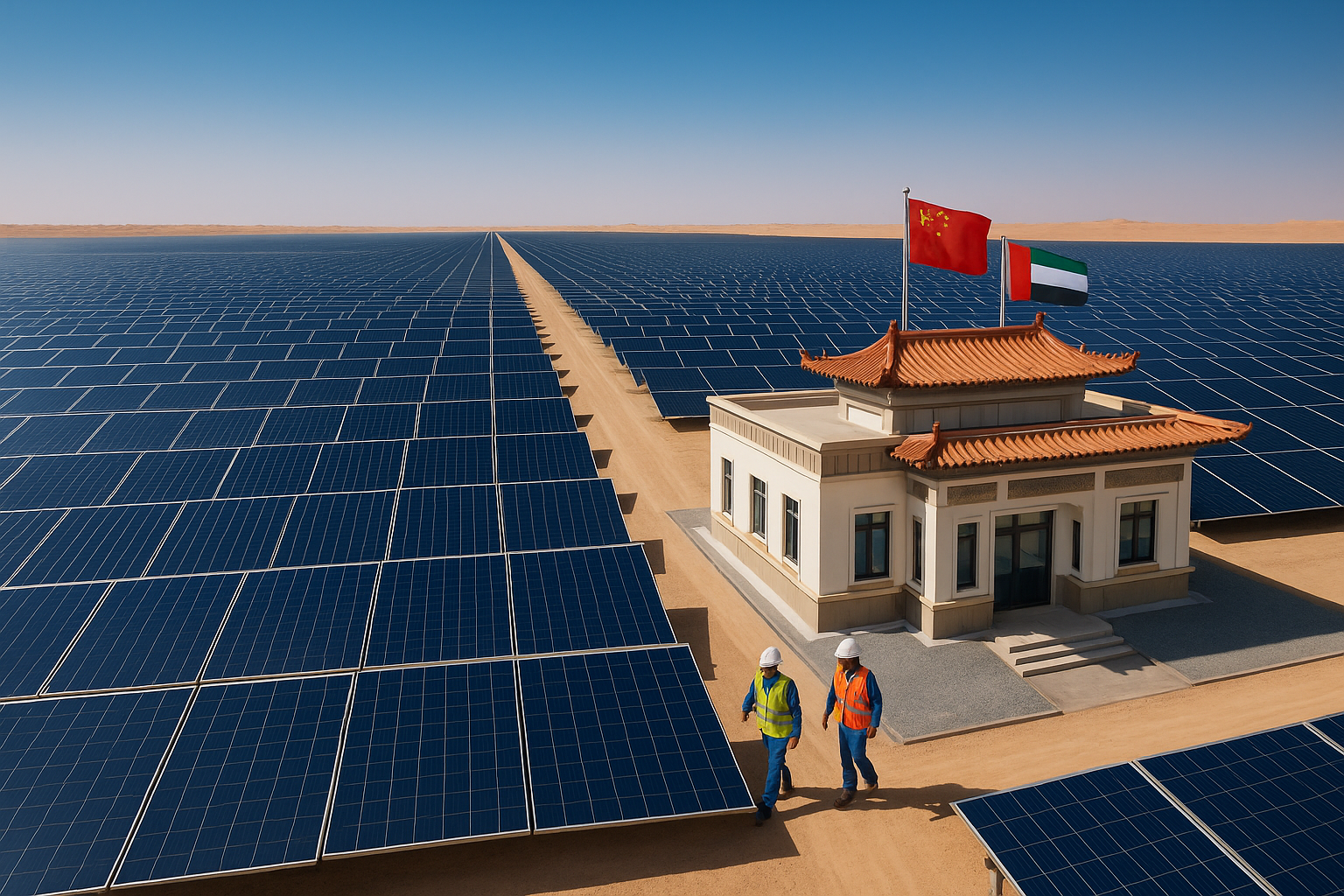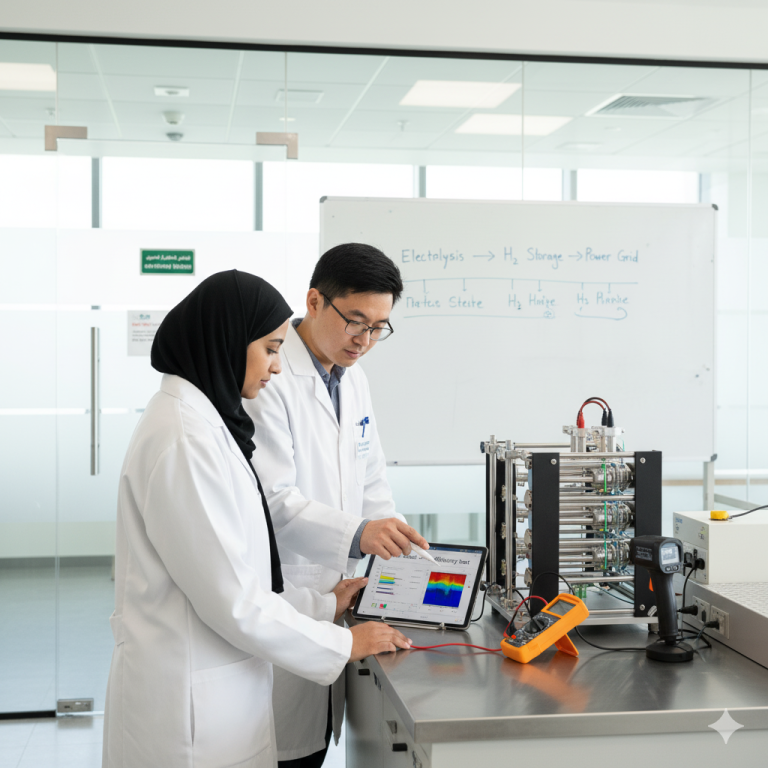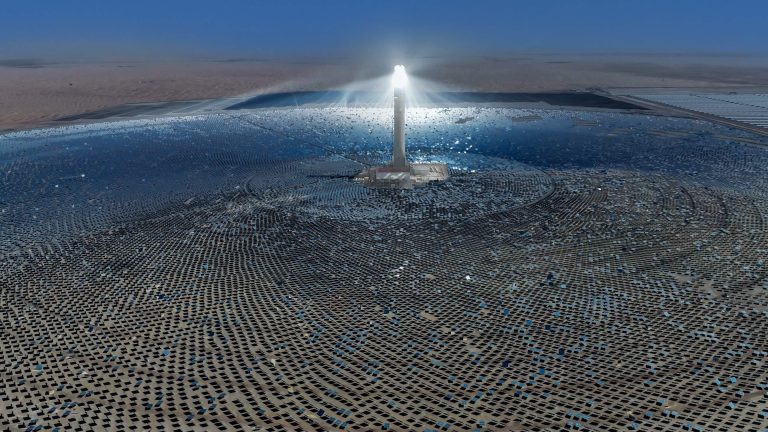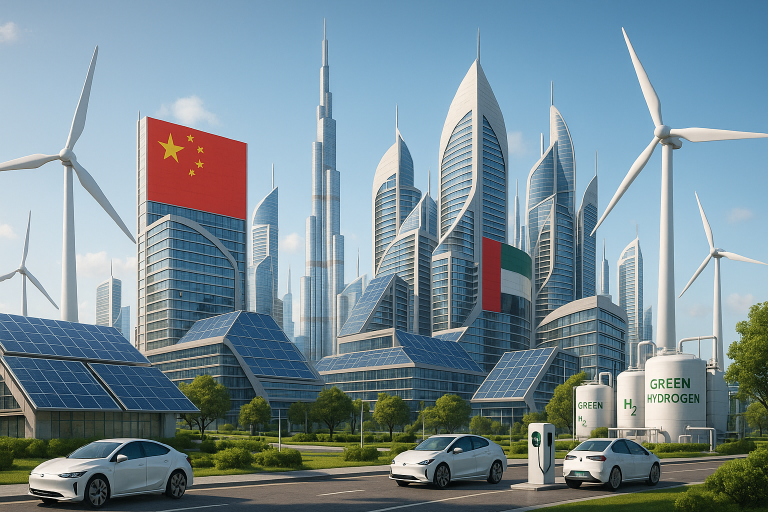The Human Factor: Forging a Future-Ready Workforce in China-UAE Energy Cooperation
In an era defined by rapid technological advancement and the imperative of energy transition, the enduring partnership between China and the United Arab Emirates (UAE) stands as a testament to strategic foresight and mutual ambition. Beyond the impressive figures of bilateral trade and monumental infrastructure projects, a more profound narrative unfolds: the cultivation of human capital. This article delves into how China and the UAE are collaboratively building a skilled workforce for the future, focusing on joint educational initiatives, knowledge transfer, and cultural exchange within their burgeoning energy cooperation.
A Partnership Forged in Vision and Trust
The relationship between China and the UAE, elevated to a comprehensive strategic partnership in 2018, is a cornerstone of regional stability and global energy dynamics. What began with the UAE becoming the first Gulf country to establish a strategic partnership with China in 2012 has blossomed into a multifaceted collaboration. The energy sector, in particular, has been a crucible for this deepening bond, with total bilateral trade exceeding $100 billion in 2024 and non-oil trade experiencing an 18% growth in Q1 2025. This robust economic foundation provides the fertile ground upon which human-centric initiatives can thrive.
The CNPC-ADNOC partnership, dating back to 2007, exemplifies this long-term commitment. From the Al Yasat Project in 2013, a joint venture between ADNOC (60%) and CNPC (40%), to CNPC’s role as asset leader for the North-East Bab Fields onshore oil concession in 2017, and cooperation in offshore fields like Umm Shaif & Nasr and Lower Zakum in 2018, these ventures are more than mere resource extraction. They are platforms for shared learning, operational excellence, and, crucially, human development. The Strategic Agreement of 2024, encompassing the entire oil and gas industry chain, further solidifies this comprehensive approach, inherently demanding a skilled and adaptable workforce.
These foundational agreements and joint ventures are not merely transactional; they represent a strategic alignment of national interests and a shared understanding of the importance of human capital. The very nature of these large-scale energy projects necessitates a continuous investment in people, from the initial planning and engineering phases to ongoing operations and maintenance. This creates a dynamic environment where knowledge transfer is not an add-on but an intrinsic component of project success. For instance, in the development of the North-East Bab Fields, CNPC’s leadership role would have involved deploying its technical expertise and operational methodologies, which would then be transferred to ADNOC’s local workforce through on-the-job training, mentorship programs, and integrated project teams. This hands-on approach ensures that local talent gains practical experience with cutting-edge technologies and international best practices, fostering a self-sustaining cycle of skill development. The complexity of modern energy projects, from advanced drilling techniques to sophisticated reservoir management, demands a workforce that is not only technically proficient but also adept at problem-solving and innovation. The China-UAE partnership actively cultivates these attributes, preparing individuals for the evolving demands of the global energy sector.
Cultivating Talent: Joint Programs and Knowledge Transfer in Action
The core of building a future-ready workforce lies in robust education and training. While formal joint university programs between China and the UAE in the energy sector may not always be explicitly highlighted in public discourse, the operational partnerships between entities like CNPC and ADNOC inherently foster significant knowledge transfer and talent development. These collaborations serve as de facto training grounds, where best practices, technological expertise, and operational methodologies are exchanged daily, often through embedded teams and cross-functional projects.
Consider the intricate details of the Al Yasat Project. As a joint venture, it would have required a seamless integration of personnel from both ADNOC and CNPC. This integration naturally leads to a direct transfer of technical skills, project management acumen, and safety protocols. Emirati engineers and technicians working alongside their Chinese counterparts would gain invaluable exposure to different operational philosophies and problem-solving approaches. This informal, yet highly effective, knowledge transfer is often more impactful than formal classroom settings, as it is directly applicable to real-world challenges within the project’s scope. Such immersive experiences accelerate learning and build practical competencies that are immediately relevant to the industry’s needs. Furthermore, the collaborative environment encourages a culture of continuous improvement and shared responsibility, vital for complex, long-term energy endeavors.
One of the most direct and formalized manifestations of this commitment to human capital development is the reciprocal talent exchange program between CNPC and the UAE. Each year, CNPC dispatches its managers to the UAE for immersive training, enabling them to assimilate local practices, understand regional market dynamics, and adapt to diverse operational environments. This exposure is critical for Chinese professionals to gain a nuanced understanding of the UAE’s energy landscape, regulatory frameworks, and cultural sensitivities, which are vital for successful long-term collaboration. These managers often return with enhanced leadership skills and a broader global perspective, enriching CNPC’s overall human resource capabilities and fostering a deeper appreciation for international cooperation.
Conversely, UAE delegations undertake visits to China, gaining invaluable insights into corporate culture, advanced management techniques, and the technological innovations driving China’s energy sector. These visits are not merely observational; they are designed to be interactive, often involving workshops, seminars, and direct engagement with Chinese energy experts and institutions. Emirati professionals can learn about China’s rapid advancements in areas such as enhanced oil recovery techniques, complex pipeline engineering, and the integration of digital technologies in upstream and downstream operations. This bilateral learning mechanism is pivotal in developing a cadre of professionals who are not only technically proficient but also culturally astute, capable of navigating the complexities of international energy cooperation. The exposure to China’s scale of operations and its innovative approaches to energy challenges provides a unique learning opportunity that complements the UAE’s own ambitious development goals.
Furthermore, the continuous flow of personnel and expertise ensures that both nations benefit from a cross-pollination of ideas and skills. For the UAE, it means access to China’s vast experience in large-scale energy project management and technological deployment, particularly in areas where China has developed unique solutions and efficiencies. This includes expertise in constructing mega-projects efficiently and cost-effectively, which is invaluable for the UAE’s infrastructure development. For China, it offers a deeper understanding of the unique operational challenges, environmental regulations, and strategic priorities within the Gulf region, allowing for more tailored and effective collaborative approaches. This bilateral learning mechanism is pivotal in developing a cadre of professionals who are not only technically proficient but also culturally astute, capable of navigating the complexities of international energy cooperation.
Beyond these direct exchanges, the broader ecosystem of collaboration fosters indirect knowledge transfer. When Chinese companies like China Machinery Engineering Corporation (CMEC) build projects such as the Al Dhafra Solar PV Plant, they often engage local contractors and suppliers. This engagement naturally leads to the transfer of construction techniques, project management methodologies, and quality control standards to the local workforce. Similarly, the long-term operation and maintenance of these facilities will require a skilled local workforce, necessitating further training and capacity building, often provided by the Chinese partners or through joint training initiatives. This creates a ripple effect, elevating the overall skill level of the local industrial base and fostering a more competitive and capable workforce across the UAE’s economy.
The Green Imperative: Skilling for a Sustainable Future
The global pivot towards sustainable energy has added another critical dimension to the China-UAE human factor equation. Both nations are deeply invested in the energy transition, with the UAE making significant strides in green energy development as part of its ambitious diversification strategy. The creation of over 10,000 green jobs in the UAE over the past 18 months underscores the urgent need for a workforce equipped with specialized skills in renewable energy technologies, energy efficiency, and sustainable practices. This demand is not merely for entry-level positions but for a full spectrum of roles, from research scientists and engineers to project developers, financial analysts, and skilled technicians, all requiring continuous upskilling and reskilling.
China’s role in this green transformation is substantial and multifaceted. Projects like Noor Abu Dhabi, the world’s largest single-site solar installation (1.2 GW), and the Al Dhafra Solar PV Plant, built by China Machinery Engineering Corporation, are not just feats of engineering; they are catalysts for local talent development. The sheer scale and technological sophistication of these projects demand a highly skilled workforce. During the construction phase, thousands of workers, both expatriate and local, are employed, and a significant portion of the local workforce receives on-the-job training in advanced construction techniques, solar panel installation, electrical systems, and safety protocols. This practical experience is invaluable, building a foundation of expertise that can be leveraged for future projects, and creating a pool of skilled labor that can contribute to the UAE’s broader green economy aspirations.
Moreover, the long-term operation and maintenance of these massive solar farms require a specialized workforce. This includes technicians proficient in photovoltaic (PV) technology, energy storage systems, grid integration, and data analytics for performance monitoring. Chinese companies, with their extensive experience in developing and operating large-scale renewable energy projects, often provide initial training programs for local Emirati staff, ensuring the smooth and efficient functioning of these facilities. This transfer of operational know-how is critical for the UAE to build indigenous capabilities in the renewable energy sector, reducing reliance on external expertise in the long run and fostering self-sufficiency in a crucial growth area.
The UAE Wind Power Demonstration Project, completed by the Power Construction Corporation of China in May 2023, further illustrates this point. Wind energy, while distinct from solar, also requires specialized skills in turbine installation, maintenance, and wind resource assessment. These projects serve as living laboratories, providing hands-on experience and facilitating on-the-job training, thereby expanding the skill set of the Emirati workforce across different renewable energy technologies. The acquisition of UAE’s Alcazar Energy Partners by China’s Three Gorges company also signifies a deeper integration into the renewable energy ecosystem, likely leading to further talent synergies and shared expertise in project development, financing, and management, particularly in emerging markets. This strategic collaboration ensures that the UAE is not just adopting green technologies but also developing the human infrastructure to sustain and innovate within this sector.
The focus on green energy also extends to research and development (R&D) and innovation. The scale of investment and collaboration in renewable energy suggests a growing need for joint research initiatives and academic partnerships. For instance, universities in both countries could collaborate on developing new materials for solar cells, advanced battery storage solutions, or smart grid technologies. Such partnerships would be crucial for fostering innovation and developing the next generation of energy scientists and engineers in both countries, ensuring that the workforce is not only skilled in current technologies but also prepared for future advancements and disruptive innovations. This forward-looking approach is essential for maintaining a competitive edge in the rapidly evolving global energy landscape, and for positioning both nations as leaders in the green energy revolution.
The Belt and Road Initiative: A Conduit for Capacity Building and Shared Prosperity
The UAE’s strategic position as a pivotal hub for China’s Belt and Road Initiative (BRI) amplifies the importance of human capital development. The BRI, with its extensive network of infrastructure and economic corridors, is not merely about physical connectivity; it often includes significant components of capacity building, vocational training, and cultural exchange in participating nations. With $70.7 billion in contracts and $51 billion in investments in 2024, including a substantial $11.8 billion in green energy, the BRI is a powerful engine for economic growth and, by extension, human development across various sectors.
Within the BRI framework, the emphasis on the human factor is paramount. It necessitates a workforce capable of managing complex international projects, understanding diverse regulatory environments, and fostering cross-cultural collaboration. The strategic infrastructure developed under the BRI in the UAE, such as advanced ports, logistics hubs, and industrial zones, requires a highly trained local workforce to operate and maintain. This creates numerous opportunities for vocational training and specialized skill development in areas like logistics management, port operations, digital infrastructure maintenance, and industrial automation. Chinese companies involved in BRI projects often establish local training centers or partner with Emirati educational institutions to provide these essential skills, thereby contributing directly to the local economy and empowering the Emirati youth. These training programs are often tailored to local needs, ensuring relevance and maximizing impact on employment and skill enhancement.
Moreover, the BRI’s focus on digital connectivity and innovation also opens avenues for talent development in emerging technologies. As both countries seek to leverage artificial intelligence, big data, and blockchain for economic diversification, joint initiatives in digital skills training and tech education become increasingly vital. This ensures that the workforce is not only equipped for traditional energy roles but also for the high-tech demands of a modern, diversified economy. The digital transformation spurred by BRI investments creates a demand for new skill sets, and the China-UAE partnership is actively addressing this through collaborative educational and training frameworks.
Cultural Exchange: The Unseen Strength of Partnership and Deepening Bonds
Beyond technical skills and economic cooperation, the human factor in the China-UAE partnership is profoundly enriched by cultural exchange. This often-understated aspect is vital for building trust, fostering mutual understanding, and creating a cohesive environment for long-term, sustainable collaboration. The research material highlights that “Cultural exchanges remain a cornerstone of the China-UAE partnership, driven by an array of cultural events, education and tourism.” While this statement is broad, it indicates a deliberate and broader commitment to cross-cultural understanding that underpins all professional and economic interactions.
More specifically, initiatives like the “100 Schools program for Chinese language teaching in the UAE,” launched in 2019, are instrumental in bridging cultural divides. Language proficiency is a direct enabler of deeper communication and understanding, breaking down barriers and facilitating more effective collaboration in technical and managerial roles within the energy sector. When Emirati professionals can communicate directly with their Chinese counterparts in Mandarin, it fosters a level of rapport and efficiency that transcends mere translation. This program not only teaches language but also introduces students to Chinese culture, history, and business etiquette, preparing them for more effective engagement in future collaborations. Such initiatives are crucial for developing a truly bicultural workforce capable of operating seamlessly across both nations.
Similarly, memorandums of understanding emphasizing cultural exchange and cooperation between universities, such as those involving Shandong province, lay the groundwork for robust academic partnerships. These partnerships can include joint research projects on energy technologies, student exchange programs that allow Emirati students to study engineering or energy management in China and vice versa, and faculty collaborations that bring together leading minds from both nations. These academic ties are crucial for fostering a new generation of professionals who possess both technical expertise and a global, cross-cultural perspective. They also serve to create a pipeline of talent that is not only technically proficient but also deeply aware of the cultural nuances that facilitate successful international partnerships.
These cultural touchpoints are not merely symbolic; they are profoundly functional. When CNPC managers train in the UAE or UAE delegations visit China, the cultural immersion that accompanies these professional exchanges is as valuable as the technical knowledge gained. It builds empathy, respect, and a shared sense of purpose, which are indispensable for long-term strategic partnerships. Understanding cultural nuances, communication styles, and decision-making processes can prevent misunderstandings and accelerate project execution. The ability to understand and appreciate different cultural perspectives enhances problem-solving, negotiation, and team cohesion in multinational projects, ultimately leading to more successful outcomes and stronger relationships. This deep cultural understanding acts as a lubricant for complex international collaborations, ensuring smoother operations and more harmonious working environments.
Furthermore, cultural exchange extends to broader societal interactions. Events celebrating Chinese New Year in the UAE, or Emirati cultural festivals in China, contribute to a greater public understanding and appreciation of each other’s heritage. This societal goodwill creates a supportive environment for economic and energy cooperation, making it easier for businesses and individuals to thrive in a cross-cultural setting. It transforms purely economic transactions into enduring relationships built on mutual respect and shared values, laying the groundwork for a truly integrated and prosperous future.
The Future: A Model for Global Energy Cooperation and Human Development
The China-UAE energy partnership, particularly through the lens of human capital development, offers a compelling model for global energy cooperation. It demonstrates that sustainable and impactful collaboration extends beyond capital investment and resource sharing to encompass the deliberate cultivation of human potential. The focus on joint training, knowledge transfer, and cultural exchange ensures that the benefits of this partnership are deeply embedded within the local workforce, contributing to long-term economic resilience and diversification.
As the world continues its journey towards a low-carbon future, the demand for specialized skills in renewable energy, digital technologies, and sustainable practices will only intensify. The proactive approach taken by China and the UAE in addressing this human factor challenge positions them at the forefront of this transition. By investing in their people, they are not only securing their own energy futures but also setting a precedent for how nations can collaborate to build a truly global, skilled, and adaptable workforce capable of tackling the complex energy challenges of the 21st century.
This commitment to the human factor transforms economic transactions into enduring relationships, fostering a legacy of shared prosperity and innovation. The skilled workforce emerging from this collaboration will be the true dividend of the China-UAE energy partnership, driving progress and shaping a brighter, more sustainable future for both nations and beyond. The continuous evolution of this partnership, driven by a shared vision for human development, promises to unlock even greater potential, ensuring that the energy sector remains a vibrant engine for growth, innovation, and cross-cultural understanding for decades to come. This strategic investment in human capital is perhaps the most significant and lasting contribution of the China-UAE energy alliance, ensuring its relevance and impact far into the future.
References
[1] China Daily. (2024, November 5). CNPC and ADNOC: a new chapter in energy cooperation for mutual benefit. https://www.chinadaily.com.cn/a/202411/05/WS672ac573a310f1265a1cbb1b.html
[2] WAM. (n.d.). UAE, China explore opportunities to strengthen…. https://www.wam.ae/en/article/bkdqy2b-uae-china-explore-opportunities-strengthen
[3] China Daily. (2025, August 31). China-UAE bilateral ties grow closer. https://www.chinadailyhk.com/hk/article/618988
[4] Middle East Institute. (2025, July 10). Northern Emirates Emerge as New Bridges in China-UAE Economic Ties. https://mei.nus.edu.sg/think_in/northern-emirates-emerge-as-new-bridges-in-china-uae-economic-ties/







